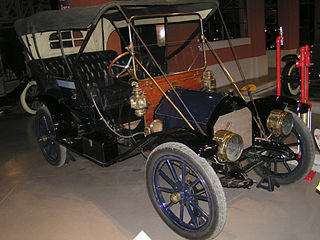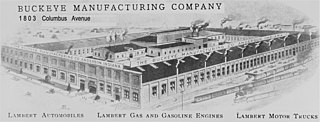Related Research Articles

McLaughlin Motor Car Company Limited was a Canadian manufacturer of automobiles headquartered in Oshawa, Ontario. Founded by Robert McLaughlin, it once was the largest carriage manufacturing factory in the British Empire.
The AGR was an English automobile built by Ariel & General Repairs of Brixton between 1911 and 1915.

The Allen was an American automobile built in Fostoria, Ohio between 1913 and 1921. The company used 3.1 liter side-valve Sommers four-cylinder engines, and acquired that company in 1915. The 1920 the Allen 43 was made, featuring bevel-sided touring coachwork and a high-shouldered radiator. Ultimately, sales of this vehicle were not enough to avert the company's bankruptcy, which followed in 1921. Willys acquired what little was left. In total, 20,00 vehicles were sold.

The Cadillac Model Thirty was an American automobile introduced in December 1909 by the Cadillac Division of General Motors, and sold through 1911. It was the company's only model for those years and was based on the 1907 Model G. The 1912 Model 1912, 1913 Model 1913, and 1914 Model 1914 were similar but used larger engines. This platform only used a four-cylinder engine which was permanently cancelled in 1914, as other GM brands would take on the task of offering a less prestigious engine. The 1912 Model 30 was the first production car to have an electric starter rather than a hand crank, spring or other early method.

A high wheeler is a car which uses large diameter wheels that are similar to those used by horse-drawn vehicles. These cars were produced until about 1915, predominantly in the United States.

The Everitt was an American automobile manufactured from 1909 until 1912 by the Metzger Motor Car Company in Detroit, Michigan.
The Etnyre was an American automobile manufactured by the Etnyre Motor Car Company in Oregon, Illinois from 1910 until 1911.
The Gadabout was an American automobile manufactured in Newark, New Jersey from 1913 until 1915. A four-cylinder cyclecar, it had a body woven from so-called "waterproof reeds". It has been described as "looking like a mobile wastepaper basket".
The Dayton Electric was an American electric car manufactured in Dayton, Ohio, from 1911 until 1915; the company offered a complex range of vehicles.

The Elcar was an American automobile manufactured from 1915 until 1931. The car was produced by the Elkhart Carriage Company, owned by William and George Pratt, of Elkhart, Indiana, which had been in business for over 30 years before producing its first car.

The Grant Motor Co was an American automobile manufacturing company from 1913 to 1922, based in Findlay, Ohio. The company produced several thousand four- and six-cylinder automobiles, and exported cars to England as Whiting-Grant. In 1916, a five-passenger touring car produced by the company sold for US$795.

The Hol-Tan was an American automobile manufactured in 1908 only.

The Hollier, also known as the Vincent-Hollier, was an automobile built in Chelsea and Jackson, Michigan by Charles Lewis, president of the Lewis Spring and Axle Company from 1915 to 1921. The Hollier was available originally with a V-8 engine of their own design. A later offering, starting in 1917, was powered by a six-cylinder Falls engine. Only open models were built. After the war ended, the company name was changed.

The Buckeye Manufacturing Company was a company noted for manufacturing gasoline engines and farm implements. It manufactured the engines for its sister company, the Union Automobile Company.

The Cameron was an American automobile manufactured by the Cameron Car Company of Rhode Island from 1902 to 1906, then in Brockton, Massachusetts, from 1906 to 1908, then in Beverly, Massachusetts, from 1909 to 1915, Norwalk, Connecticut, in 1919, and finally in Stamford, Connecticut, in 1920. No cars were produced from 1915 to 1918. The company made two-, four-, and six-cylinder models.
The automotive industry in Massachusetts refers to a period of time from 1893 to 1989 when automobiles were manufactured in the Commonwealth of Massachusetts commercially. In the early years, the state produced more automobiles than Detroit, Michigan. During the 20th century, General Motors and the Ford Motor Company were producing automobiles at the Framingham Assembly and Cambridge Assembly, respectively.
The Series 20 was an automobile produced by Oldsmobile Division of General Motors in 1909. When the Oldsmobile Company joined General Motors in 1908, the Series 20 was one of the first examples of platform sharing that became GM's most notable business model, as it was derived from the previously established Buick brand from the Buick Model B. The Series 20 effectively replaced the Model F, also known as the Curved-Dash Oldsmobile, when it was discontinued when GM assumed operations, and was replaced by the 1914 Oldsmobile Model 42 "Baby Olds". It was the entry-level vehicle below the Oldsmobile Model A and the luxury sedan Oldsmobile Model Z. It was the first Oldsmobile to use numbers to identify the product, a tradition that would last until the company concluded operations in 2004.
The Model 42 was an entry-level four seat passenger car produced by GM's Oldsmobile Division in 1914. It was offered as a replacement to the Oldsmobile Curved Dash runabout when it was discontinued in 1908, and was the junior platform to the Oldsmobile Six introduced in 1913. GM had acquired Elmore Manufacturing Company, Oldsmobile and Oakland Motor Car Company in 1908 and Cartercar and Rainier Motor Car Company in 1909 as their entry-level models, and Oldsmobile products were being repositioned in their new hierarchy as GM began to consolidate operations after William Durant had left.
The Series 22 Special was a four-seat passenger car produced by the Oldsmobile Division of GM in 1910 and 1911. It was the first car engineered by Oldsmobile after it became a division of GM and began sharing a platform with the Buick Model 10. It became the entry-level model for Oldsmobile, replacing the discontinued 1909 Model 20 and the 1909 Model D, while Oakland Motor Car Company became GM's entry level brand as Chevrolet didn't join GM until 1917.
References
- 1 2 3 4 5 6 7 Kimes, Beverly (1996). Standard Catalog of American Cars 1805-1942. Krause publications. ISBN 0-87341-428-4.[ page needed ]
- Burgess-Wise, David (2000). The New Illustrated Encyclopedia of Automobiles. BookSales Inc; Rev Upd edition (May 2000). ISBN 0-7858-1106-0.[ page needed ]